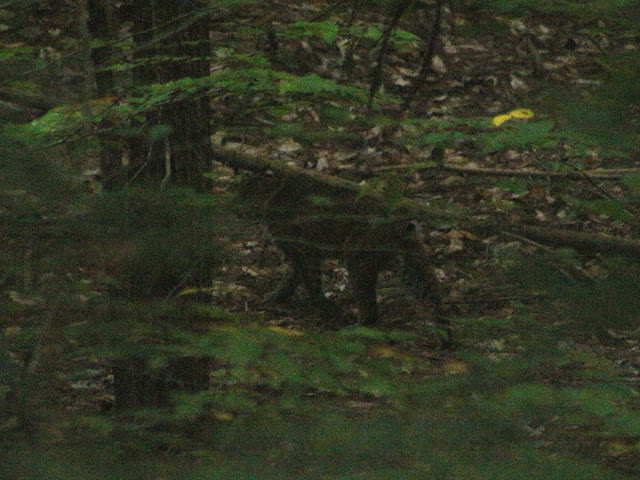The palette of the lake is becoming less varied by the day as November gathers near, but there are still splashes of brightness to be found: shiny red partridge berries, deep orange beech leaves, bright green moss, and gently frosted oak leaves.
 |
| Oak leaves on a frost morning. |
Many cultivated flowers survived the first freeze on Friday night so if you planted some hardy flowers in your garden this summer they are likely still blooming.
 |
| Linda's foxglove continue to bloom. |
A very few wildflowers are also soldiering on.
 |
| The aptly named Frost Aster (Symphyotrichum pilosum) |
But most have passed by. Even the goldenrod has succumbed to the cold.
 |
| Goldenrod, no longer golden. |
The most prevalent hues in the forest now are green needles and brown leaves. Shuffling though the blanket of leaves on the forest floor this week I was struck by the amount of energy that trees put into the thousands of leaves they construct every summer, just to cast them off in the fall. Each of these tiny chemical factories - and a single oak tree might have a quarter of a million leaves on it - spends the summer taking carbon dioxide from the atmosphere, and using solar energy, manufacturing the sugars that are essential to the plant's existence, as well as to every animal on the planet. And when the factory shuts down in fall, a deciduous tree just lets them all go.
But then I realized the tree is not actually done with them. In fact, trees may be the original recycling plant. Once the leaves and all other tree debris are on the ground a whole new biological system of fungus, bacteria, and other life forms takes over. There are literally billions of living organisms that process this organic material and in turn allow the tree to reabsorb many of the nutrients it put into making those leaves.
A single teaspoon of soil in the forest contains billions of living organisms, including perhaps half a millions round worms, half a billion fungi, and many billions of bacteria. [National Geographic, Sept. 2022, Ferris Jabr, pg. 92] Most of these are obviously microscopic and far too small to see with the naked eye, but some, such as the snow flea which I most often see in the winter when their black dots stand out on top of a white layer of snow, can be readily observed. These organism seen under high magnification are absolutely fascinating, many of them having legs and mouths, and look like creatures from a Star Wars movie. The above referenced article has amazing pictures of them taken with an electron microscope. All these organisms decompose those leaves, releasing the nutrients within, which can then be taken up again by the tree and many other plants and animals.
The past week's events brought us to our childhood home of Concord Massachusetts where we had a moment to visit the the Old North Bridge, the scene of the "Shot Hear 'Round the World" (Ralph Waldo Emerson). Although just 90 miles to the south of the Lakes Region, some trees in Concord have many of their factories still attached, though even there the production of carbohydrates has ceased.
 |
| A maple tree at the Old North Bridge. |
While marveling at the beautiful colors that nature gives us I noticed a nice size hornets next snuggled in with the leaves.
 |
| A bald faced hornet's nest by the "rude bridge that arched the flood". (Also Emerson) |
The inhabitants of the nest are likely gone at this point, but I'll bet there were a lot of hornets buzzing the tourists all summer.
We witnessed no musket fire at the revolutionary battle field, but we did see a huge red-tail hawk fly across the open field and land in a tree directly above us.
 |
| A bird of prey stands sentry over the historic battlefield. (Poor photo - all I had was my phone.) |
This bird was clearly acclimated to tourists as it had no concern with us at all and spent the next hour flying from tree to tree searching the field for small animals as people passed near by.
Back in New Hampshire, cool nights means fog has been forming over the lake - perfect for the upcoming spooky night.
Happy Halloween!






















































